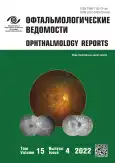The use of platelet-rich plasma and two-component autofibrin glue in treatment of experimental chronic persistent corneal erosion
- Authors: Toloknova V.A.1, Gavriluk I.O.1, Churashov S.V.1, Kulikov A.N.1
-
Affiliations:
- Kirov Military Medical Academy
- Issue: Vol 15, No 4 (2022)
- Pages: 53-60
- Section: Experimental trials
- URL: https://journals.rcsi.science/ov/article/view/144093
- DOI: https://doi.org/10.17816/OV110728
- ID: 144093
Cite item
Abstract
BACKGROUND: The use of platelet-rich plasma (PRP) and its modifications are a promising treatment method for chronic inflammatory diseases of the cornea.
AIM: To evaluate and compare the clinical and morphological features of the corneal regeneration during experimental chronic persistent corneal erosion with the use of PRP and two-component autofibrin glue (TAFG).
MATERIALS AND METHODS: The studies were conducted in 18 rabbits (36 eyes). After modeling chronic persistent corneal erosion, the animals of the 1st group were treated with TAFG; animals of the 2nd group — with instillations of PRP, animals of the 3rd group — with standard medical therapy.
RESULTS: By Day 14 of the experiment, the restoration of the transparency of the cornea, no erosion and new vessels in animals of the 1st and 2nd group were noted. This pattern persisted until Day 60. By Day 30 of the experiment, the presence of corneal clouding in optical zone, neovascularization over the whole cornea and an epithelial defect (3,85 [3,50; 4,47] %) in animals of the 3rd group were recorded. By Day 60, a complete epithelialization of the cornea was observed.
CONCLUSIONS: The use of PRP and TAFG allows reducing the time of corneal epithelialization by 2,5 times in conditions of experimental chronic persistent corneal erosion. There were no significant differences between the use of PRP (within 5 days) and TAFG, however, treatment with an adhesive composition is more convenient for both the doctor and the patient — a single use that does not require multiple use of expensive consumable materials.
Keywords
Full Text
##article.viewOnOriginalSite##About the authors
Violetta A. Toloknova
Kirov Military Medical Academy
Author for correspondence.
Email: toloknova.violet@mail.ru
student of the residency in the specialty “ophthalmology”
Russian Federation, Saint PetersburgIlya O. Gavriluk
Kirov Military Medical Academy
Email: iluaayaks@gmail.com
ORCID iD: 0000-0003-0932-2818
SPIN-code: 9649-7311
Cand. Sci. (Med.), Lecturer of the Department of Ophthalmology
Russian Federation, Saint PetersburgSergey V. Churashov
Kirov Military Medical Academy
Email: churashoff@mail.ru
ORCID iD: 0000-0003-1197-9237
SPIN-code: 5370-7410
Dr. Sci. (Med.), Professor of the Department of Ophthalmology
Russian Federation, Saint PetersburgAlexei N. Kulikov
Kirov Military Medical Academy
Email: alexey.kulikov@mail.ru
ORCID iD: 0000-0002-5274-6993
SPIN-code: 6440-7706
Scopus Author ID: 198153
ResearcherId: M-2094-2016
Dr. Sci. (Med.), Chief of the Department of Ophthalmology
Russian Federation, Saint PetersburgReferences
- GBD2019 Blindness and Vision Impairment Collaborators, Vision Loss Expert Group of the Global Burden of Disease Study. Causes of blindness and vision impairment in 2020 and trends over 30 years, and prevalence of avoidable blindness in relation to VISION2020: the Right to Sight: an analysis for the Global Burden of Disease Study. Lancet Glob Health. 2021;9(2):144–160. doi: 10.1016/S2214-109X(20)30489-7
- Borovkova NV, Filatova IA, Chentsova EV, et al. Efficacy of platelet-rich plasma lysate in patients with corneal erosion or post-traumatic scarring of the tissues of the eyelids. Russian Ophthalmological Journal. 2020;13(3):8–14. (In Russ.) doi: 10.21516/2072-0076-2020-13-3-8-14
- Anitua E, de la Sen-Corcuera B, Orive G, et al. Progress in the use of plasma rich in growth factors in ophthalmology: from ocular surface to ocular fundus. Expert Opin Biol Ther. 2022;22(1):31–45. doi: 10.1080/14712598.2021.1945030
- Patent RU № 2704256 / 25.10.2019. Byul. № 30. Gavrilyuk IO, Kulikov AN, Kuznetsova AYu, et al. Sposob prigotovleniya autologichnogo dvukhkomponentnogo fibrinovogo kleya. Available from: https://patenton.ru/patent/RU2704256C1.pdf (In Russ.)
- Kulikov AN, Churashov SV, Gavrilyuk IO, et al. Experimental model of recurrent corneal erosion. Ophthalmology in Russia. 2019;16(2): 230–235. (In Russ.) doi: 10.18008/1816-5095-2019-2-230-235
- Tarabrina VA, Gavrilyuk IO, Churashov SV, et al. Effect of platelet-riched plasma on corneal epithelium regeneration during its chronic erosion (experimental study). Ophthalmology in Russia. 2021;18(3): 552–559. (In Russ.) doi: 10.18008/1816-5095-2021-3-552-559
- prplab.ru [Internet]. Instruktsiya po primeneniyu sistemy Ycellbio-Kit firmy Vaisellbiomedikal [cited: 2022 Aug 28]. Available from: http://www.prplab.ru/metod-prp.htm (In Russ.)
- Sukhinin MV. Morfologicheskaya kharakteristika perednego ehpiteliya rogovitsy i sosudistogo rusla kon’’yunktivy glaznogo yabloka v norme i pri mekhanicheskom povrezhdenii perilimbal’noi zony [dissertation abstract]. Saint Petersburg, 2011. (In Russ.)
- Voino-Yasenetskii VV. Razrastanie i izmenchivost’ tkanei glaza pri ego zabolevaniyakh i travmakh. Kyiv: Vishcha shkola, 1979. (In Russ.)
- Inatomi T, Nakamura T, Koizumi N, et al. Midterm results on ocular surface reconstruction using cultivated autologous oral mucosal epithelial transplantation. Am J Ophthalmol. 2006;141(2):267–275. doi: 10.1016/j.ajo.2005.09.003
- Fedoseeva EV, Chentsova EV, Borovkova NV, et al. Morphofunctional peculiarities of platelet rich plasma and its application in ophthalmology. Ophthalmology in Russia. 2018;15(4):388–393. (In Russ.) doi: 10.18008/1816-5095-2018-4-388-393
- Kim KM, Shin YT, Kim HK. Effect of autologous platelet-rich plasma on persistent corneal epithelial defect after infectious keratitis. Jpn J Ophthalmol. 2012;56:544–550. doi: 10.1007/s10384-012-0175-у
- Nurden AT, Nurden P, Sanchez M, et al. Platelets and wound healing. Front Biosci. 2008;13(9):3532–3548. doi: 10.2741/2947
- Chentsova EV, Fedoseeva EV, Petrova AO, et al. Use of platelet rich plasma lysate when standard therapy is inefficient in patients with corneal erosions. Modern technologies in ophthalmology. 2020;(4):45–46. (In Russ.) doi: 10.25276/2312-4911-2020-4-45-46
Supplementary files













